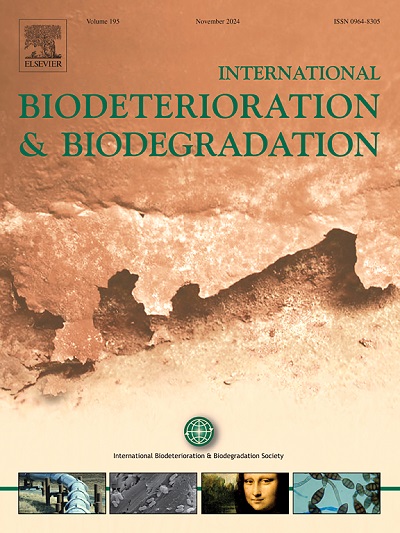纳米零价铁介导的微藻系统优化对水产养殖废水中营养物和抗生素的高效去除
IF 4.1
2区 环境科学与生态学
Q2 BIOTECHNOLOGY & APPLIED MICROBIOLOGY
International Biodeterioration & Biodegradation
Pub Date : 2025-05-06
DOI:10.1016/j.ibiod.2025.106114
引用次数: 0
摘要
本研究旨在研究纳米零价铁(NZVI)对微藻系统去除水产养殖废水中营养物质和抗生素的影响。水产养殖业的快速扩张造成了严重的污染问题,因为其废水中含有丰富的营养物质和抗生素。基于微藻的处理技术前景光明,但NZVI对其性能的影响尚不清楚。建立了4种不同NZVI浓度(0 mg L−1、5 mg L−1、10 mg L−1、20 mg L−1)的体系。结果表明,10 mg L−1的NZVI对微藻生长的促进效果最好,以处理2(小球藻+内生细菌+蔷薇绒螯虾)效果最好。对COD、TN、TP和四环素的去除率分别为87.29±8.04%、87.76±8.32%、88.12±8.45%和99.17±0.52%。本研究确定了最佳工艺和NZVI浓度,为微藻在水产养殖废水处理中的应用提供了重要的理论支持。但是,需要注意的是,为了充分确认其有效性,仍需要实际规模的验证。本文章由计算机程序翻译,如有差异,请以英文原文为准。

Nano zero-valent iron mediated optimization of microalgae-based systems for efficient nutrient and antibiotics removal from aquaculture wastewater
This study was dedicated to investigating the influence of nano zero-valent iron (NZVI) on microalgae-based systems in eliminating nutrients and antibiotics from aquaculture wastewater. The aquaculture industry's fast expansion has caused severe pollution issues, as its wastewater is rich in nutrients and antibiotics. Microalgae-based treatment technologies hold promise, yet the effects of NZVI on their performance remain unclear. Four systems were established with different NZVI concentrations (0 mg L−1, 5 mg L−1, 10 mg L−1,20 mg L−1). Results showed that 10 mg L−1 of NZVI best promoted microalgae growth, and Treatment 2 (Chlorella vulgaris + endophytic bacteria + Clonostachys rosea) performed best. Its removal efficiencies of COD, TN, TP, and tetracycline reached 87.29 ± 8.04 %, 87.76 ± 8.32 %, 88.12 ± 8.45 %, and 99.17 ± 0.52 % respectively. This research identified the optimal technology and NZVI concentration, providing crucial theoretical support for the application of microalgae in aquaculture wastewater treatment. However, it should be noted that real-scale validation is still required to fully confirm its effectiveness.
求助全文
通过发布文献求助,成功后即可免费获取论文全文。
去求助
来源期刊
CiteScore
9.60
自引率
10.40%
发文量
107
审稿时长
21 days
期刊介绍:
International Biodeterioration and Biodegradation publishes original research papers and reviews on the biological causes of deterioration or degradation.

 求助内容:
求助内容: 应助结果提醒方式:
应助结果提醒方式:


